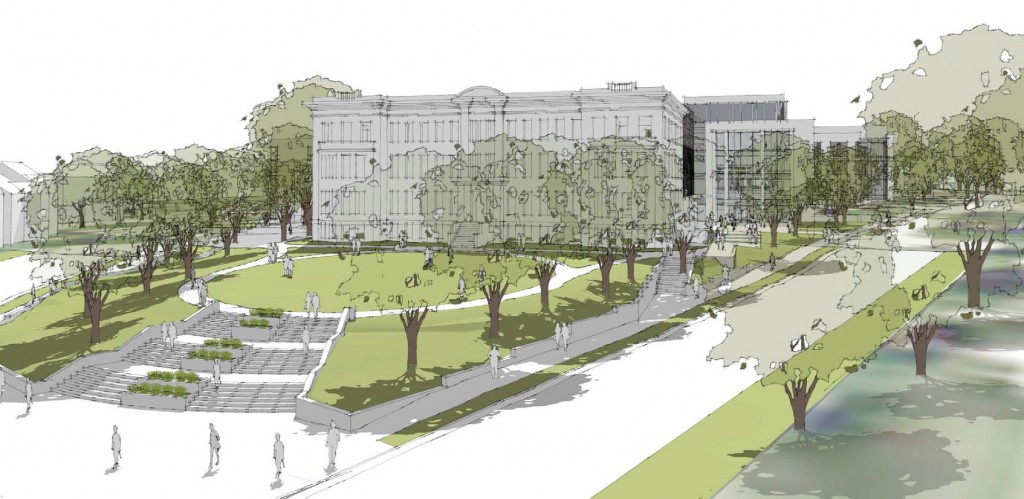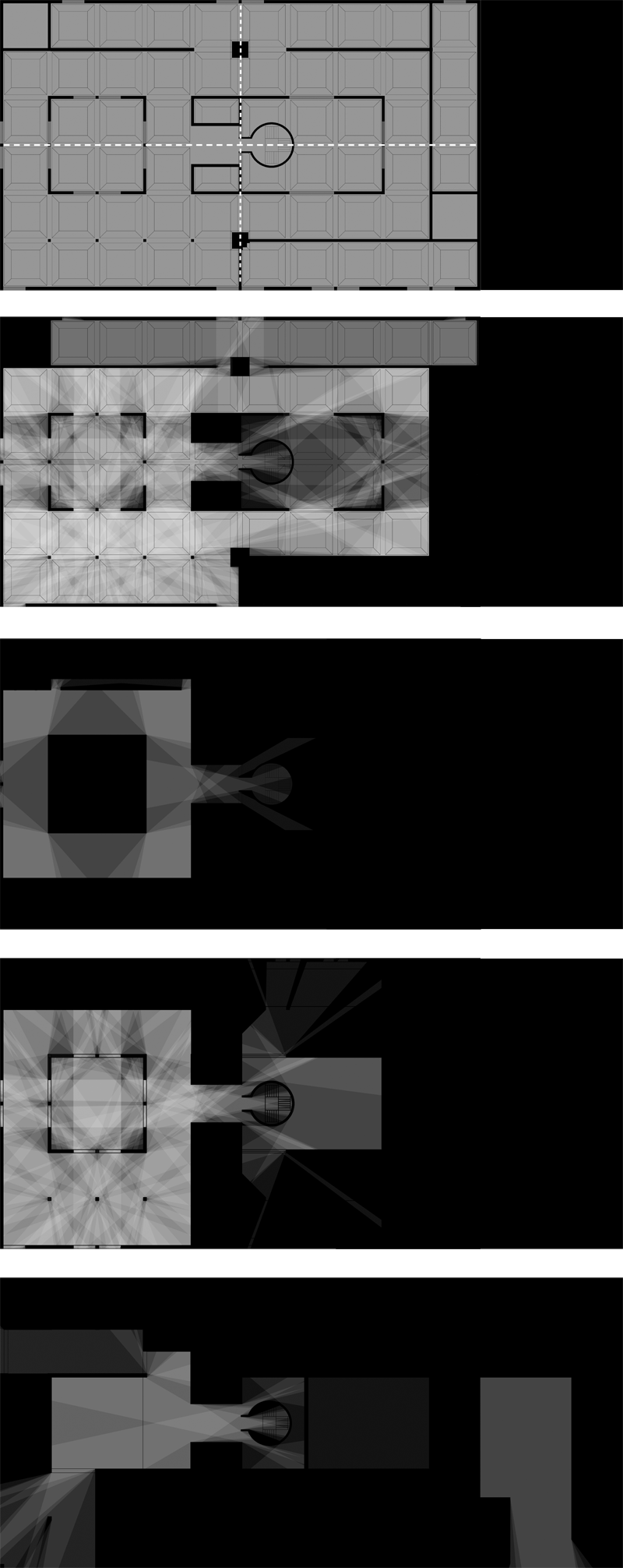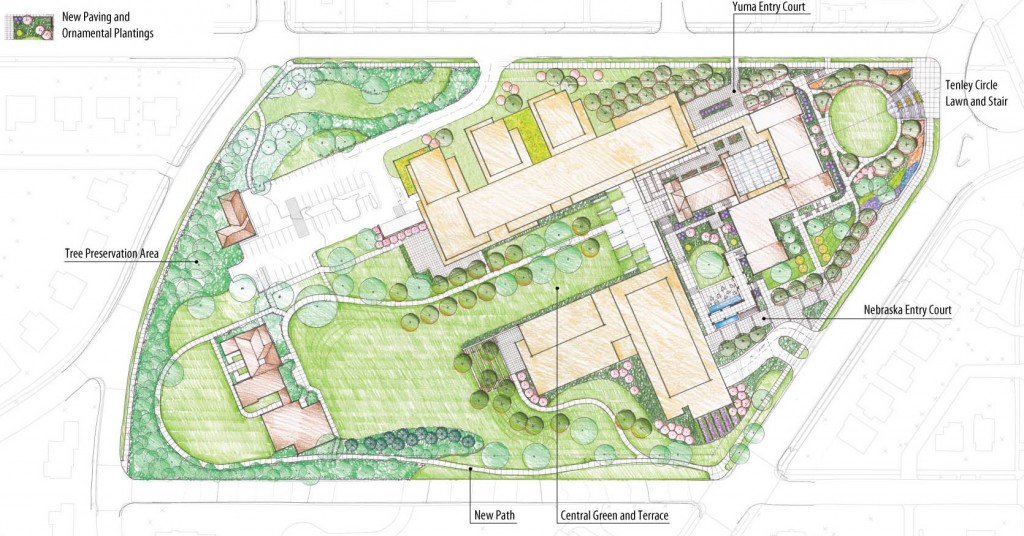I’ve seen parts of the film before it had the professional narration, and even though I am more interested in baseball stadiums than baseball games, the very old story of dreams and exploitation was still fresh.
Defining “Building Information”
Since we were not selected, it seems in the spirit of things to publish the proposal in hopes that it can germinate other ideas in topics we ourselves were blind to. The original proposal included the names of proposed authors, which have been edited out.
A Failed Proposal for Perspecta 48:
BUILDING INFORMATION MODELING
Building information modeling has become fait accompli in the discipline of architecture. Sales of Revit subscriptions steadily rise, while technical facility becomes commonplace. Resignation to BIM’s inevitability has caused a critical blindness toward the nature, forms, and influence of those first two words, “building information.”
For Perspecta 48, we propose to step back and investigate unresolved aspects concerning the use of knowledge in design and construction. As a metaphor for the discipline’s approach, consider the parable of the blind monks and an elephant.
A king brings a pachyderm to a few sightless monks as a test. He asks them to reach out and describe this “elephant” they had never before encountered. Unable to perceive the whole creature, each groped at different body parts and returned a correspondingly different answer, all rooted in something familiar. The tail became a whip, the body a granary, the tusk a plow, and one man declared the leg to be a column.
When the king revealed the elephant, he showed their wisdom to be burdened by two key epistemological errors: assuming one has the full scope of information on a subject and, secondly, relying on preconceptions to understanding new information. By approaching the issue from a business side and avoiding theory, the discipline has ceased examining information in a multifaceted way, as it once did.
Forty years ago, researchers like Charles Eastman and Nicholas Negroponte imagined software reminiscent of information modeling and parametricism. Over the next forty years they worked to realize these dreams. But at the same time, the scope of the theoretical aims narrowed from world order to interface to tool and finally to product. In order to produce viable software, designers had to cut back their ambitions to basic commercial goals. Speculation on the radical political uses of data or how digital tools transform our relationship to the physical have been left to coders at the margins.
To reorient the debate, Perspecta 48 looks at “building information” from five key angles. Taking a fundamental perspective, the authors in the first section will examine the epistemology of building. By this we mean what is considered constructional knowledge, and how the discipline organizes it. Another group will look at the ways simulation and dematerialization have transformed humans and their environment.
A third set explores the diverging ends of authority and participation on that building modeling is driving the profession to. Looking at the politicization of knowledge, one group will examine how information multiplies of power and raises new ethical dilemmas. Finally, one collection of essays will discuss the technical difficulties of realizing architecture with digital technologies, and even how to embrace them.
We aspire to reinvigorate the discourse about building information by revealing it to be not merely a technology, but rather as a fundamental element of architecture.
The proposal continues.
Drawing is Dead, Long Live Drawing
The highlight of the series, for me, was (go straight to it) was Andrew Witt’s discussion of the much longer use of computer drawings than the architecture profession typically admits. Witt is director of research at Gehry Technologies, and spent a few years studying 19th-century mechanical tools to reliably draw the complex shapes desired by Beaux-arts architects but very challenging to obtain with the accuracy or precision needed to actually construct a building. So it’s a very interesting talk. Patrik Schumacher, on the other hand, does nothing but embarrass himself and bloviate.
Here are links to all of the sessions, each three hours long, except for the keynote, #4.
- The Voice of Drawing: The history of and an apologia for hand drawing.
- Burning Bridges, Questioning Practice: New technologies and scientific developments in design.
- The Critical Act: What are we trying to do when we design?
- Real is Only Halfway There: Peter Cook on how architects draw for each other.
The answer to the question, BTW, was that drafting is dead, but sketching will be around as long as we have bodies. Seems simple enough, right?
Rock Creek Park

Oddisee has been a bit of a thing in DC since he showed up a couple of years ago, but since summer’s coming around, I’d like to bring up his mixtape from last year, Rock Creek Park. When I graduated from high school, I don’t think that I could have imagined a hip-hop album about anything within a half-mile of my parents house that wasn’t a tryin’ it homage to Maret’s lunch menu, but hey, things change. And it’s really great, as both music and also for what it represents.
The instrumental album, I suppose, feels like the park. At the least, it feels like a great soundtrack to rolling around the park when your mind’s at ease. The opener, “Still Doin’ It,” establishes the theme with collaborator y.U.’s lyrics about biking and driving around DC. That kind of multimodal use of the city warms the cockles of this urbanist’s heart. The symphonic “Carter Barron” plays off the go-go rhythms of “Clara Barton.” Oddisee throws pretty much any sound you can find in DC together and makes it work. And doesn’t “Closed After Dark“ let you know that the Blackbyrds still know what goes on there?
Anyhow, check it out. It’s local. And still fresh.
New St. Thomas Church Looks Good
I hadn’t heard much news about the new sanctuary in a while, but I came across this video, and the design looks great. The project has definitely improved since I last looked over it in 2010. The architect, Auraform, seems to be using materials very deliberately, so it will be interesting to see how those choices produce and affect and carry the design.
I am particularly fond of the way the roof overhang at the entrance relates to the cross, as a both a sign and as a part of the composition. The visceral handling of the ruins of the old church, towards the end of the video, is certainly reminiscent of Zumthor’s Kolumba Art Museum, with attached exterior windows that owe a lot to Sigurd Lewerentz‘s St. Peter’s, Klippan. There’s a lot going on in the building.
DC has recently gained a strong set of exceptional modern churches, of which this building will certainly be one. Jarvis, at least, worked for well-published hermitect Peter Zumthor and the less reclusive local rising star, David Jameson.
Eisenman/Robertson: The Odd Couple
It’s vacation time around here, and that gets us thinking about the olden days. So let’s take a trip back to the time when the leading proponent of deconstruction in architecture and the Dreihaus Prize-winning designer of Celebration, Florida once worked together. Happy holidays!
Arguing the sand from under their homes
Just as some residents are fighting the potential of AU’s campus expansion, so too did an earlier generation fight the development of the parcels that abut the five-acre parking lot that AU wants to turn into a leafy complex of low-rise residential buildings.
A substantial amount of opposition has arisen in Westover Place, a gated complex of rowhouses between Massachusetts Avenue and Foxhall Road. They have been the most vocal and ANC 3D meetings, insisted that AU build its buildings next to other people’s homes, and it was the meeting point of this summer’s traffic protest.
But in 1977, it was the threat of Westover Place that was vexing locals. According to a September 25th, 1977 Washington Post article: “And to the north of this, adjacent to the 5-acre university parking lot, Kettler Brothers Inc., the giant development company that built Montgomery Village, has already cleared more than eight acres where 149 town houses will be constructed. Houses in this development, Westover Place, will sell from about $135,000.”

In the article, entitled “Bulldozers at the Estates,” Phil McCombs reports on arguments and characters not unlike the current fights over American University’s expansion and other developments in the area. Just as before, opponents are appealing to a right of first arrival, but the article lays bare the hypocrisy in living in a development while fighting a development because it will have the same effects your house did. The rowhouses of Westover Place and similar developments paved over Northwest’s last open spaces that seemed so essential to the “rural” character of piedmont Washington.
Similarly to the opposition to the 1960 Tenley Library and the 1941 Sears Roebuck, an enormous to-do was made over the development and yet both became established elements of the community. At that time, however, the changes seemed signified the end of something unique. McCombs quotes the ANC3 Commissioner Polly Shackelton bemoaning the change:
“Here you have these fine established residential neighborhoods, which will be impacted with increased density and traffic and all kinds of things that really could be very damaging,” she said. “I think in a way it’s too bad we don’t have a comprehensive plan.”
She said that development of the Rockefeller estate, for example, “will be devastating because Foxhall Road is already crowded. With 100 new houses there, I don’t know how we’ll deal with it.”
The problematic idea here is “establishment:” that because a neighborhood has reached any level of development, it should be maintained as it is. Are the current residents who now enjoy this property more justified than their neighbors who lived there in 1977, or estate owners who lived there in 1917?
Visibility in the Yale Center For British Art
Diagram of cumulative sightlines in the public spaces of Louis Kahn’s Yale Center for British Art (1974), without display panels.
DC HPO says the Tenley Campus is a District

The Historic Preservation Office has released their recommendations for the Tenley Campus ahead of this Thursday, the 27th’s, HPRB hearing. In an unusual decision, they have advised the HPRB to approve the current design, and also to declare the entire campus as a historic district. The Tenleytown Historical Society’s nomination did not ask for an all-encompassing district, but rather a single landmark designation for the entire campus. Their reasoning:
Guidance provided by the National Register suggests that campuses should generally be considered districts, although there are smaller campuses that consist of little more than a central building or two and surrounding space. In the present instance, a district better accommodates the different origins and ages of the major contributing elements of Immaculata, in a manner similar to the often varied neighborhood historic districts.
I find this reasoning plausible at face value. It’s also not unprecedented. Gallaudet’s campus is a historic district, and Georgetown University may be. The details are more complicated, however. Gallaudet’s district covers much more territory and more historic buildings. Other, similarly sized properties that are not schools have been named landmarks. Indeed, the district only includes three-and-a-half buildings:
The historic district should be designated with the following three buildings considered to contribute to its historic character: the original Immaculata Seminary, i.e., [the 1904] Capital Hall, including its 1921 rear wing; the 1921 Chapel; and Dunblane. The three 1955 buildings should be considered non-contributing, as beyond the campus’s period of significance and representing a phase of school expansion distinctly different architecturally and functionally from the founding era. The 1921 garage should also be considered non-contributing because an addition has considerably altered it and diminished its integrity, nearly doubling its size and closing its original vehicular openings. The sense of clustering campus buildings surrounded by and enclosing landscape, as well as the site’s traditional orientation of, and relationship between, buildings should also be maintained and preserved
Dunblane has been renovated multiple times and burned once. It is unrecognizable from whatever form it may have had. I am fine with leaving a form or mark on the campus, but there is no reason to preserve the building itself if the equally altered garage can go.
I do not necessarily understand why they chose this designation. I have some conjectures:
- It is the result of negotiations between AU and the other parties. A district designation would most likely preserve the rear green space in perpetuity, but give some design flexibility to AU.
- This gives the HPRB more latitude in deciding what happens to the property.
- It is easier to justify a district designation than a full landmark designation, given the historic resources.
I do not know the minds of the HPO, but I hope that the reasons for the designation are closely interrogated before the HPRB makes a decision.
As seen in the images, AU recently revised their plans to include a common area at the front of the building, released a traffic report, and also revealed a much-improved (planometrically) North Hall. Both images courtesy AU.
Marion Barry, Russian Punchline
А.ВЕНЕДИКТОВ: Мэр Москвы Сергей Собянин. Прежде чем мы прервемся на 2 минуты и передадим слово нашим корреспондентам, мы хотим вам сделать подарок, Сергей Семенович. Это книга бывшего мэра Нью-Йорка Рудольфа Джулиани «Лидер», который принял Нью-Йорк городом мафиозным и тяжелым, ну а, как говорят те, кто там живут, когда он ушел, этот город стал пригоден для жилья всем. Так что, я думаю, вдруг она вам понравится.С.СОБЯНИН: Спасибо, что не от мэра Вашингтона.А.ВЕНЕДИКТОВ: Да-да. (смеется) От мэра Вашингтона ни в коем случае. 2 минуты перерыва, потом наши корреспонденты.
VENEDIKTOV: We’re with the Mayor of Moscow, Sergei Sobyanin. Before we take a two minute break and let our correspondents have a word, we would like to give you a gift, Mr. Sobyanin. It’s the book, Leadership, by former New York mayor Rudolph Giuliani, who turned New York City from a frightful mafia-infested wreck to the kind of a city, the residents who lived there when he left said, that was safe for all. So, I think you’ll take a liking to him.SOBYANIN: Well, thanks for it not being from the Mayor of Washington.VENEDIKTOV: Heavens, no. (Laughs) No way we’d give you something from the mayor of Washington. Two minute break, then our correspondents’ questions.
Leadership was translated in 2004. I’m not sure why they’re handing it out now, but there it is, next to DC’s shame, circa 1990.


